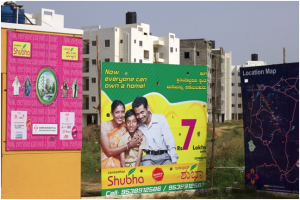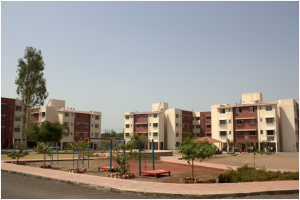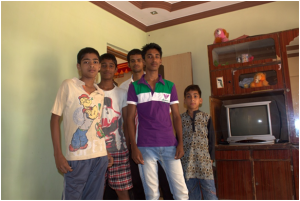Microfinance Focus, 16 October 2012, Co-authored with Vikash Kumar
This article is part of a series aimed at understanding what’s happening in India’s affordable housing sector. It is based on interviews with residents of three low-cost housing projects: Vaishnavi Sai (outside Mumbai), Anandgram (outside Pune), and Janaadhar Shubha (outside Bangalore). The interviews were conducted during May-June 2012. Read Part 2 here.
Something is afoot in the low cost housing market in India. Over the last two years, dozens of commercially-built projects targeted at the lower middle class have been going up in cities across the country, with tens, if not hundreds, of thousands of units being built. In the past six months, many of these projects have begun opening their doors to the new residents. We decided to pay some of them a visit.
Our brief journey took us from Mumbai’s downtown chowls to its outer suburbs, from rural towns outside Pune to the outer environs of Bangalore’s famed Electronic City. In each place we spoke with simple folk – rickshaw drivers, railway workers, factory hands, smalltime business owners, technicians, retirees, teachers, men, women, and yes, the ubiquitous school-age cricketers who inhabit every courtyard in India. We sought to understand them, their needs, their motivations, and most importantly, listen to their stories.
What is low cost, anyway?
|
“I never dreamed of being able to afford my own home. But after visiting the MHFC stall, I became very happy – I might be able to manage this flat!” |
But first things first. When we say low cost or affordable housing, we have specific figures in mind. Using the methodology from a series of Monitor Group studies conducted in 2009-10, which define low cost housing as Rs 3-10 lakhs ($5,500-$18,000) that’s targeting households with monthly incomes of Rs. 7,500-25,000 ($136-$455). Monitor estimated that there are 20 million households in urban India that fit this profile, or one quarter of all urban households.
At the three projects we visited, the cost was indeed within the target window – initial starting prices of one bedroom (1BHK) units ranged from Rs. 3.25 lakhs ($6,500) in Pune to Rs. 7 lakhs ($12,000) in Mumbai. Still, cost is but one part of the affordability equation. The other is affordable credit. Of all the residents we spoke with, only one elderly couple had purchased their flat with cash, using savings they’d built up over time (a dream they’d been waiting to fulfill for 30 years!). The rest all relied on mortgage finance, without which the projects would’ve been inaccessible, regardless of the low cost. As one recent homeowner and worker at a spice factory outside of Pune put it: “I never dreamed of being able to afford my own home. But after visiting the MHFC [Micro Housing Finance] stall, I became very happy – I might be able to manage this flat!”
Sacrificing for the dream of homeownership
Despite the low cost and affordable mortgage financing, buying a home is still a challenge for most low income families. Yet the dream of homeownership is strong, and to reach it families are willing to sacrifice much.

An advertising placard shows the target family for Janaadhar Shubha, with newly-completed buildings in the background (outskirts of Bangalore)
What would motivate families to expend so much more on housing than they had previously? Is it the opportunity to buy into a hot market? To some extent, yes. At the oldest project – Vaishnavi Sai – prices have already doubled over the past year. Still, one shouldn’t make too much of this argument.Buying a home involves a huge increase in housing expense. For many of the buyers we interviewed, the cost of mortgage payments (not counting the cash down-payment) was double their previous rent. In one extreme case, a client went from a rental costing Rs. 3,500/mth ($63) to a mortgage arrangement of Rs. 11,500/mth ($209) – an increase of more than three-fold.
For many buyers, their willingness to sacrifice went well beyond financial expense. At Janaadhar Shubha outside Bangalore, many clients mentioned that the physical location – an entirely residential neighborhood far from markets and commerce – was less than ideal. Sure, they valued the fresh air and open space. But then we asked two women directly – would they have moved there if, instead of purchased units, these had been rental flats charging the same rent they were paying before? The answers were both unequivocal: no. This, despite the fact that they spoke well of the quality of the construction, the building managers, and their neighbors. For the family of one rickshaw driver, there was another sacrifice – because of the long travel time and the cost of fuel, he was forced to spend every other night with relatives in Bangalore, rather than go back home. Yet, it was a price they were willing to pay: “We have to bear some suffering to have our own home!”
The dream of homeownership is a universal phenomenon, but in India it has some uniquely local attributes. Many residents spoke of the dysfunctional relationships they had with their landlords. It’s not just the frequent increases in rent that everyone complained about. The problem went deeper – with landlords acting at times almost capriciously, by turning off water or complaining about visitors, for example – families in rental flats simply didn’t feel free. For them, purchasing a home was as much an assertion of freedom as of financial capacity.
Indeed, freedom in the context of low-cost housing in India has still another important connotation – independence from the often stressful social environment of the multi-generational family compound. Though not one person said so directly, that motivation was barely hidden under the surface. At one project, two brothers who had previously lived together in the same house bought adjoining flats – close, yet still separate.
Beyond affordability: what clients want
Fresh air and open space. Buying homes may be a dream worthy of sacrifice, but it does come with some general minimum requirements. After low cost, the theme of fresh air and open space was the single most frequently cited reason for buying into the project. This is notable. After all, building in distant suburbs is done out of necessity – cheaper land – and this is often seen as a potential obstacle due to the lengthy commute. Yet it’s obvious from speaking to the residents that it’s also an important advantage. India’s cities are hot, crowded places – escaping to less-crowded suburbs holds has its own attraction.
The construction itself – large courtyards, good ventilation – is likewise important. One spice factory worker put it directly: “Before, the air in my flat was stifling, so when I came back from work, I had to go sleep outside. Here I can sleep in my own flat.” All the projects we visited observed this design element, and it’s one worth remembering.
Accessibility. Suburban or not, accessibility to the urban center is still an issue. All three projects featured a rail station nearby – an advantage emphasized by many. That said, a large portion of residents worked nearby and had no regular connection to the city. Thus, while rail accessibility is important for being able to tap into demand from the urban center, it’s possible that less connected projects may still prove economical when located further away. As railroad suburbs expand, building further can be a useful way to segment the market between those that require ready access to the city and those that do not.
|
What clients want:
|
Distance to rail station may be optional to some, but that doesn’t apply to markets and schools. At one project, where the closest markets were a few kilometers away, their absence was mentioned repeatedly as a real inconvenience by several women. In that case, a schoolbus and a regular shuttle bus to the suburban center helped mitigate this issue substantially, but complete suburban isolation is still inadvisable. Even with some small provisions on-site – space for shops, a school, a small medical center –no developer can replace the advantage of an entire town commercial center.
Community. At Vaishnavi Sai, where the first residents moved in nearly 2 years ago, the sense of community was very strong. Children and teenagers would wander from one flat to another as if they owned both. Even at the barely 1-month old Janaadhar Shubha, children had no hesitation to go to one teacher’s flat in the morning to remind her that it was time for school. As with children, so with their mothers, who spoke nearly unanimously of the sense of community they felt in the new developments, much as they might’ve said about an older chawltry or a slum.
It’s an interesting comparison – at one chawltry in downtown Mumbai, a group of elderly men similarly praised their community: neighbors celebrating festivals together or helping out those who fall sick. They had heard of the new communities being build outside the city, but according to them, there “the doors are closed.” This divergence between expectations and actual experience is important – developers selling on the basis of nothing more than marketing materials and a sample flat can do little to dispel buyer concerns about the kind of community they’ll be living in. As more such communities come up, perceptions will change, but some proactive marketing – videos or even visits to already settled communities – may help as well.
Homeowner or investor?
Not all of the buyers of the flats intend to live there. Investors were present in all three projects, though were most visible in Anandgram (Pune), where they owned as many as 50% of the units. Such high numbers could certainly be a cause for concern, since empty units held as assets can drive up prices, undermine the sense of community, and contribute to a speculative bubble.
At Anandgram we ran into two such investors. Both were long-term buyers: one had purchased two adjoining units, with plans to rent one and keep the other as a weekend home for himself. The second investor bought one unit that he was planning to rent out. It’s difficult to say in advance how their rental plans will be realized – especially when so many of the units have been bought by investors. Current residents knew of only a handful of tenants, with most investor units remaining empty. However, the project is still under construction – only time will tell what impact investor properties will ultimately have.
One might consider extrapolating from earlier projects. At Vaishnavi Sai (Mumbai) – investors weren’t a significant issue. With some units completed as far as two years back, all or nearly all flats were occupied. While a quarter of the flats were owned by investors, they too were occupied by tenants. The community didn’t seem to suffer as a result of their presence. However, with a 50% rate of investor-ownership in Anandgram, the impact may well be more corrosive.
Next steps in the affordable housing journey
Housing is among the topmost issues facing low income families. In the coming weeks and months, we’ll be publishing more detailed findings from our visits to these three projects, and will examine other aspects of this broad and complex subject.
It’s time we give housing the attention it deserves.


Leave a Reply